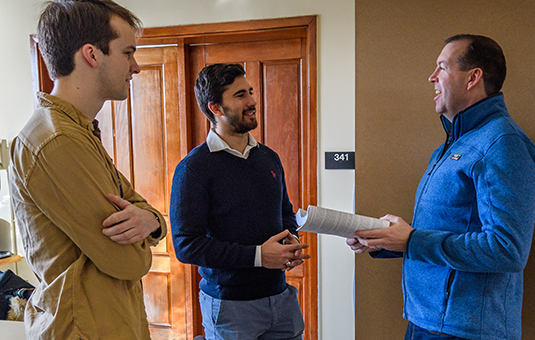Computer Science
Our faculty are connected to the latest trends in computing practices and research. Research interests range from classical and quantum computing to human-computer interaction to assistive technology to artificial intelligence and speech recognition, and so much more.
Submissions from 2012
Iterative approximate byzantine consensus in arbitrary directed graphs, Nitin H. Vaidya, Lewis Tseng, and Guanfeng Liang
Submissions from 2011
Observation of two families of folding pathways of BBL, Jue Fan, Mojie Duan, Da Wei Li, Hao Wu, Haijun Yang, Li Han, and Shuanghong Huo
Click control: Improving mouse interaction for people with motor impairments, Christopher Kwan, Isaac Paquette, John J. Magee, Paul Y. Lee, and Margrit Betke
Adaptive mouse-replacement interface control functions for users with disabilities, John J. Magee, Samuel Epstein, Eric S. Missimer, Christopher Kwan, and Margrit Betke
Enhancing social connections through automatically-generated online social network messages, John J. Magee, Christopher Kwan, Margrit Betke, and Fletcher Hietpas
Submissions from 2010
Interactive learning using manifold geometry, Eric Eaton, Gary Holness, and Daniel McFarlane
Uniqueness of optimal mod 3 polynomials for parity, Frederic Green and Amitabha Roy
Explicit parametrizations of the configuration spaces of anthropomorphic multi-linkage systems, Li Han and Lee Rudolph
Plug-in vehicles and the plug - Policy to address the chicken or the egg problem, John Magee
HAIL: Hierarchical adaptive interface layout, John Magee and Margrit Betke
Adaptive mappings for mouse-replacement interfaces, John J. Magee, Samuel Epstein, Eric S. Missimer, and Margrit Betke
Towards a multi-camera mouse-replacement interface, John Magee, Zheng Wu, Harshith Chennamaneni, Samuel Epstein, Diane H. Theriault, and Margrit Betke
Submissions from 2009
Efficient universal quantum circuits, Debajyoti Bera, Stephen Fenner, Frederic Green, and Steve Homer
Simplex-tree based kinematics of foldable objects as multi-body systems involving loops, Li Han and Lee Rudolph
Bending and kissing: Computing self-contact configurations of planar loops with revolute joints, Li Han, Lee Rudolph, Sam Dorsey-Gordon, Dylan Glotzer, Dan Menard, Jon Moran, and James R. Wilson
Submissions from 2008
Uniqueness of Optimal Mod 3 Circuits for Parity, Frederic Green and Amitabha Roy
Stratified deformation space and path planning for a planar closed chain with revolute joints, L. Han, L. Rudolph, J. Blumenthal, and I. Valodzin
Predicting the folding pathway of engrailed homeodomain with a probabilistic roadmap enhanced reaction-path algorithm, Da Wei Li, Haijun Yang, Li Han, and Shuanghong Huo
Convexly stratified deformation spaces and efficient path planning for planar closed chains with revolute joints, Han Li, Rudolph Lee, Jonathon Blumenthal, and Ihar Valodzin
Submissions from 2007
A unified geometric approach for inverse kinematics of a spatial chain with spherical joints, Li Han and Lee Rudolph
Structural and pathway complexity of β-strand reorganization within aggregates of human transthyretin(105-115) peptide, Da Wei Li, Li Han, and Shuanghong Huo
Temperature-dependent probabilistic roadmap algorithm for calculating variationally optimized conformational transition pathways, Haijun Yang, Hao Wu, Dawei Li, Li Han, and Shuanghong Huo
Submissions from 2006
Quantum lower bounds for fanout, M. Fang, S. Fenner, F. Green, S. Homer, and Y. Zhang
Inverse kinematics for a serial chain with joints under distance constraints, Li Han and Lee Rudolph
Submissions from 2005
Bounds on the power of constant-depth quantum circuits, Stephen Fenner, Frederic Green, Steven Homer, and Yong Zhang



